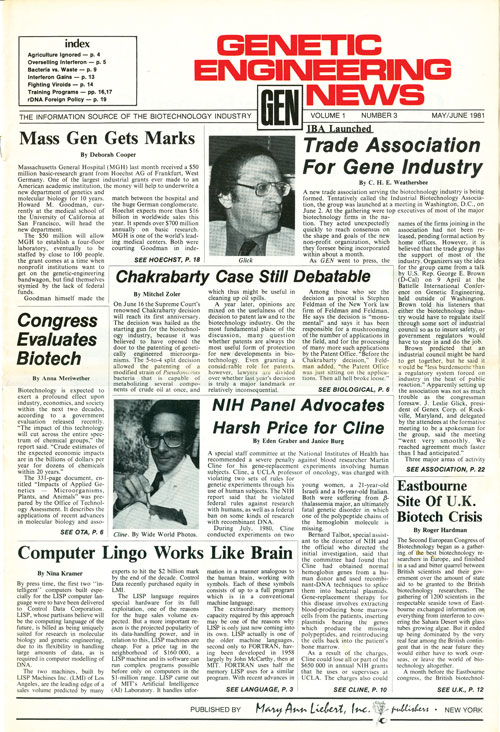June 15, 2011 (Vol. 31, No. 12)
Editor’s Note
Later this month, BIO will hold its annual conference. BIO provides advocacy, business development, and communications services for its members worldwide. BIO came into existence in 1993 through the merger of two groups. One was the Association of Biotechnology Companies (ABC) and the other was called the Industrial Biotechnology Association (IBA). We chose this issue’s article commemorating GEN’s 30th Anniversary to provide a bit of an historical perspective on the formation and role of biotech industry trade organizations. We are publishing a story from the May/June 1981 issue that was written by GEN’s first editor, Chet Weathersbee, about the initial formation of the IBA.
In reading the story note that some of the same issues of concern to the fledgling biotech industry are still on BIO’s agenda today. The person chosen to serve as spokesperson for the IBA was J. Leslie Glick, then president of long-gone Genex. I am sure many of you have noticed that Glick, who occasionally writes a column for GEN, is still much interested in biotech today.
And if anyone knows Chet Weathersbee and where we can find him please let us know. We would be delighted to have him write a few words for our 30th Anniversary issue in October.
—John Sterling, Editor in Chief
“As Seen in GEN”—Flashback Volume 2, Number 3, May/June 1981
IBA Launched: Trade Association For Gene Industry
By C.H.E. Weathersbee
A new trade association serving the biotechnology industry is being formed. Tentatively called the Industrial Biotechnology Association, the group was launched at a meeting in Washington, D.C. on June 2. At the gathering were top executives of most of the major biotechnology firms in the nation. They acted unexpectedly quickly to reach consensus on the shape and goals of the new non-profit organization, which they foresee being incorporated within about a month.
As GEN went to press, the names of the firms joining the association had not been released, pending formal action by home offices. However, it is believed that the trade group has the support of most of the industry. Organizers say the idea for the group came from a talk by U.S. Rep. George E. Brown (D-Cal) on 9 April at the Battelle International Conference on Genetic Engineering, held outside of Washington. Brown told his listeners that either the biotechnology industry would have to regulate itself through some sort of industrial council so as to insure safety, or government regulators would have to step in and do the job.
Brown predicted that an industrial council might be hard to get together, but he said it would be “less burdensome than a regulatory system forced on industry in the heat of public reaction.” Apparently setting up the association was not as much trouble as the congressman foresaw. J. Leslie Glick, president of Genex Corp. of Rockville, Maryland, and delegated by the attendees at the formative meeting to be a spokesman for the group, said the meeting “Went very smoothly. We reach agreement much faster than I had anticipated.”
Three major areas of activity were agreed upon at the meeting. They were government relations, education, and the creation of forums for the discussion of industry issues. Glick said the three goals will be as follows:
- “Governmental relations, specifically: to monitor and inform members on government activities: to develop and present industry views to agencies and legislators; and to develop codes of desirable practice for the industry.
- “Educational initiatives, specifically: to develop high-quality, factual materials on various biotechnology topics to present to audiences of community leaders, governmental decision makers, and students, so as to build goodwill and to lay a foundation for familiarity with, and acceptance of, products derived from biotechnology.
- “Discussion of issues, specifically: to provide forums through recurrent committee meetings and conferences; to provide a center for discussion: and to provide means for those outside the industry to exchange ideas, views, and criticisms with us, the association.”
Though consensus was reached on the formation of an association and on its broad goals, setting up will be guided by an interim executive committee consisting of a group of the organizers. This committee, Glick said, will be actively recruiting new members for the association “so the organization will be of sufficient size to have a functioning professional staff.” As yet, no firm decisions have been made either on the size of the staff or the location of the office. In view of the governmental-affairs function, Glick conceded, Washington “might be a good possibility,” but he said nothing has been settled on yet.
“We anticipate the launching of a staff search as being one of the first concerns we will be facing once the association has enough members to reach the critical mass,” Glick said. “We expect to have a full-time executive director and staff, ultimately to include technical people, public-relations people, and support staff, although it will start off more modestly than that.”
Glick said that the group acted so quickly because of Brown’s advice at the Battelle meeting, that it would be “in the best interests of the industry as a whole to set up a mechanism for a trade association, to fill what would otherwise be a void.” Of the meeting, Glick said that “most people saw eye-to-eye on the need for such an association, and were able to respond pretty quickly. It was basically a very positive response.”








